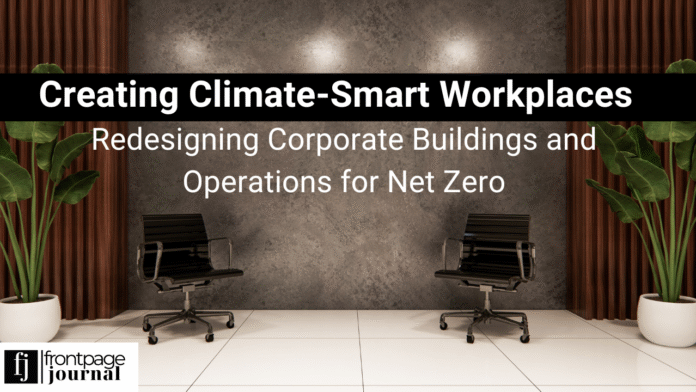As global pressure mounts to transition toward net zero, the role of the workplace has become central in the conversation about sustainability. Corporate buildings, office operations, and facility management are no longer viewed simply as overhead or infrastructure. They are now pivotal areas where emissions can be cut, resources can be optimized, and environmental leadership can be demonstrated. For CEOs and business leaders aiming to future-proof their organizations, the creation of climate-smart workplaces is no longer a desirable enhancement. It is a strategic necessity.
Buildings account for nearly 40 percent of global carbon emissions when both operational and embodied emissions are considered. In Sri Lanka, the rise in commercial real estate, energy consumption, and urban density adds another layer of urgency. As cities grow and energy grids become strained, efficient corporate operations can ease the pressure while also reducing long-term operating costs. Energy efficiency, renewable integration, and sustainable building design are emerging as clear pathways for businesses to contribute meaningfully to national and global climate goals.
Retrofitting existing buildings is one of the highest-impact areas for emission reduction. From HVAC optimization and LED lighting to automated building management systems and low-flow water fixtures, the return on investment is often immediate. Upgrading insulation, installing sensor-based lighting and ventilation, and investing in energy-efficient appliances can cut operational costs while significantly lowering a company’s carbon footprint. In regions where air conditioning is a major energy drain, smart climate control systems can make a measurable difference in both cost and emissions.
For new construction projects, adopting green building standards such as LEED, EDGE, or WELL can help companies design facilities that are energy efficient, water smart, and employee focused from day one. Incorporating passive solar design, daylighting, rainwater harvesting, and rooftop solar generation can create buildings that generate a portion of their own energy and reduce reliance on fossil fuel-based electricity. These practices also send a strong signal to stakeholders and investors that environmental impact is being taken seriously at the foundational level.
Workplace sustainability must also go beyond buildings and into operations. Shifting toward a paperless culture, implementing strict waste segregation, digitizing workflows, and optimizing office supply procurement are practical steps that can be embedded into daily routines. Organizations can also switch to renewable energy sources through rooftop solar installations or green energy purchasing where available. Even small steps such as unplugging devices after hours, managing elevator use, or adopting hybrid working policies can make a measurable difference.
Equally important is employee awareness and engagement. A climate-smart workplace is not built through infrastructure alone but through behavior. Engaging employees in sustainability programs, carbon literacy sessions, and climate-friendly commuting incentives creates a culture of responsibility and shared purpose. Internal campaigns that highlight sustainability milestones, reward green behavior, or crowdsource ideas from staff help turn climate goals into collective achievements.
Digitization plays a key enabling role. Smart office technology allows companies to monitor energy use in real time, track emissions, and identify inefficiencies. Dashboards that display live energy data or resource consumption encourage accountability and allow for data-driven decision-making. Cloud-based collaboration tools reduce the need for travel, printing, and physical storage, enabling a leaner operational model with a lighter environmental footprint.
For companies that occupy leased spaces, collaboration with landlords becomes essential. Businesses must begin to demand sustainability clauses in leasing agreements, requesting energy efficiency benchmarks, air quality monitoring, and building-level recycling programs. Where direct investment is not possible, influencing the sustainability performance of shared spaces is still a valid and impactful step.
Being climate-smart also means designing for resilience. With extreme weather events becoming more frequent, buildings must be prepared for floods, heatwaves, and power disruptions. Incorporating climate risk into facility planning ensures business continuity while demonstrating a long-term commitment to environmental resilience.
A climate-smart workplace also enhances brand value and employee attraction. Increasingly, talent chooses employers not only based on compensation but on values. A company that actively reduces its environmental footprint, supports employee wellbeing, and fosters a sense of purpose is more likely to retain top talent and build a loyal culture. Investors too are beginning to look at how operational practices reflect stated ESG commitments. Buildings that walk the talk serve as visible proof of a company’s values.
In a future where carbon pricing, green procurement, and regulatory pressures are only set to increase, the cost of inaction is rising. Forward-thinking companies must view their workplaces not just as spaces of productivity but as platforms for sustainability leadership. Designing climate-smart operations is no longer about ticking a box. It is about aligning every square meter of a company’s footprint with its long-term business vision and climate responsibility.
The path to net zero runs through the places where we work. Every building redesigned, every kilowatt saved, and every employee empowered to act is a step closer to making business not just part of the economy but part of the solution.




